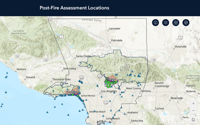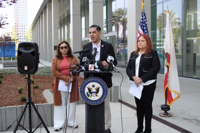
Alzheimer’s is the most common type of dementia in the U.S., affecting older women the most. Photo by Steven HWG
Imagine one day you start having trouble coming up with the right word or misplacing a valuable object like your laptop or phone.
After some time, you or a family member notices that you start forgetting bigger events or personal history like your wedding day or the birth of your first child. You start being unable to control your bladder and bowels, and one day you find yourself lost in the middle of your daily afternoon walk.
Time passes, and you now require around-the-clock assistance with daily personal care like eating, washing and even swallowing your food. You are no longer aware of your surroundings, and communicating efficiently is now an impossible task.
This is the reality that approximately seven million people in the United States encounter every day while living with Alzheimer's.
Alzheimer's, which is the most common type of dementia, strikes the parts of the brain that control memory, thought and language. It is a slow disease that progresses in three stages – an early(preclinical stage, often with no symptoms, a middle stage with mild cognitive impairment) and a final or late stage.
To raise awareness, promote early detection and support people living with Alzheimer's, as well as their families and caregivers, the California Department of Public Health (CDPH) and the Los Angeles County Department of Public Health hosted an event with leading clinical and public health experts to discuss Alzheimer's disease and disparities that exist in Los Angeles County.
The event was held on Thursday at St. Anne’s Family Services in Silverlake and was part of an ongoing campaign titled “Take on Alzheimer’s,’ or “Take on ALZ,” launched by the CDPH in March.
“With more people living longer lives, the number of Californians living with Alzheimer’s disease and Related Dementias (ADRDs) is projected to double over the next 20 years, even as the percentage of older adults with dementia declines,” Dr. Tomás J. Aragón, CDPH director and State Public Health Officer, said. “This campaign will empower our diverse communities to support brain health, better understand the difference between signs of aging and symptoms of dementia and encourage individuals to have important conversations with their loved ones and health care providers.”

(Left to right) Douglas Nelson, Miriam Hernandez, Dunia Elvir, Jun Hori, Soo Borson, Dr. María P. Aranda and Tony Kuo. Photo by Brenda Verano
Thursday’s event helped bring together health and community experts like Dr. María P. Aranda, executive director of the USC Edward R. Roybal Institute on Aging and director of outreach for the Recruitment and Engagement Core of the USC Alzheimer’s Disease Research Center; Soo Borson, clinical professor of family medicine at Keck Medicine of USC; co-lead of the BOLD Center on Early Detection of Dementia at New York University Langone and the Southern California Dementia Improvement Network; Jun Hori, Manager of Care and Support Services, Little Tokyo Service Center; Douglas Nelson, pastor, at the True LA Church and Miriam Hernandez, workforce development manager, with Visión y Compromiso.
May, which is known as National Older Americans Month, helped bring awareness to the growing number of elders who are being diagnosed or showing early signs of Alzheimer’s, many of whom are Latinos.
Data from California’s State of Public Health report identified Alzheimer's disease as the second leading cause of death and the number one cause of death in adults 85 years and older. The CDPH also stated that by 2040, California’s population will have expanded by 16%, yet the number of adults living with Alzheimer’s disease will have expanded by 127%, or nearly 1.6 million adults.
In L.A. County, Alzheimer's is also the second leading cause of death, as shared by Tony Kuo, director of the Division of Chronic Disease and Injury Preventionfor L.A. County’s Department of Public Health.
“This is just based on recent mortality data from 2022,” he said during Thursday's event. “The other thing to point out is that in L.A. County, we have more than 322,000 caregivers, and we believe even that is very much an underestimate because a lot of people and families do not always identify themselves as caregivers.”
During the panel discussion, Aranda, who has studied Alzheimer's for over 30 years and who initially developed Spanish-language support groups for families affected by Alzheimer’s disease, talked about the importance of early detection and diagnosis.
“Early detection allows the individual to make plans about their own lives in terms of where they want to live, what type of living arrangement they want, their finances, their legal affairs and also what they don't want,” Aranda said. “We know that people who do develop dementia later in life have had symptoms for at least 15 years earlier, if not more. I'm a licensed clinical social worker, and some of my clients have lost their homes because of their inability to take care of their financial affairs. Knowing these things early on could avoid other crises, but it also gives us the opportunity to look at more of the hopeful picture of things and not just at the devastation. If,detected early, [people with Alzheimer’s] can live very fruitful lives for a long time.”
Alzheimer’s disease must be diagnosed by a specialist. Although there is no singular or specific test to determine if an individual is living with Alzheimer’s, physicians often use various tests and procedures. Some may use medical history, mental status tests, physical and neurological exams, diagnostic tests and brain imaging. Aranda said early detection can also be the first step to planning for the future by making sure the affected person’s wishes are followed and that others can make decisions once they are no longer able or capable.

Panel discussion at Thursday'’s event for Alzheimer’s prevention. Photo by Brenda Verano
“Family members, when they seek help, it's typically when the person with Alzheimer's is exhibiting symptoms that are in the later stages. By then, many things have occurred in the family that hae been crisis-driven, so that's why they come in for treatment. Not having them come in earlier for an assessment, evaluation and diagnosis is a disservice that we need to support and aid,” Aranda told CALÒ News.
The panel of speakers also talked about the negative stigmas that surround the topic of Alzheimer’s. Many of the negative stigmas installed within certain communities leave no space for talking openly about this disease and instead turn it into a taboo topic. Borson said that it is important to know that Alzheimer’s is also not a normal part of growing older, as many people think. Misconceptions around significant memory loss as a normal sign of aging are often what leave many elders undiagnosed.
Alzheimer's disproportionately affects Latinos and Black/African-American people in California and L.A. County. According to the CDPH Alzheimer’s Disease Program, older Black Americans are two times more likely to develop Alzheimer's, followed by Latinos, who are one a half times more likely to develop the disease.
“African-Americans and Latinos already have a disparity in health care, they already have a disparity in access to health care so it's even more important that we inform our community so that they do know to go and get this information and be aware of the Alzheimer's symptoms,” Nelson said.
In L.A. County, where the majority of the population is Latino, Alzheimer's rates have also gone up in the last few years, following California’s trend. It’s the second leading cause of death in the county.
This number is exceedingly alarming, as many residents continue to be reluctant to seek public health care. This is especially true among low-income immigrants who are reluctant to seek care for fear of jeopardizing their residency and citizenship, even risking deportation, according to the University of California, Los Angeles, Latino Policy & Politics Institute.
A similar study, the 2023 KFF/LA Times Survey of Immigrants, confirmed that many low-income, undocumented people in California remain uninsured, even if many are now eligible for programs like Medi-Cal. Nearly three-quarters of immigrant adults, including nine in ten of those who are likely undocumented, report uncertainty about how use of these programs may impact immigration status or incorrectly believe use may reduce the chances of getting a green card in the future. About a quarter (27%) of likely undocumented immigrants and nearly one in ten (8%) lawfully present immigrants say they avoided applying for food, housing or health care assistance in the past year due to immigration-related fears.
The unwillingness to seek care for some people also comes from distrust or unfamiliarity with the healthcare system in general. Things like language barriers are often a barrier for many people to feel comfortable and believe like they belong within the healthcare system.
“We have to ask ourselves: why is it that many people don't trust the doctors? Many times people trusted a physician, a nurse or even a medical social worker and other people in the health sector, and they were met with a type of care that was inferior, belittling, inaccurate, inadequate, etc.,” Aranda told CALÒ News. “What I have found that has helped is that if an individual is concerned about their memory, they need to share that with a trusted person, somebody in their social network, whether it's a family member, a cousin, a sister, a spouse or even a close neighbor or close friend that they trust and ask if they can support them and accompany them to see a physician or a doctor.”
She adds, “We do know that there's some distrust and we know that a lot of times that distrust comes from very uncomfortable interactions with healthcare providers because I've seen it myself. When we go to the doctor, we're under a little bit of anxiety. We're going to the doctors because something's happening, we don't feel well, they might have to do tests and we’re nervous about what they're going to say and do. Having a person of confianza, with us, can help.”
When it comes to Alzheimer's, being uninsured can take a big toll on being able to afford the care.
The National Institute of Health estimates that the costs of formal Alzheimer’s care average approximately $27,672 per patient annually, with long-term care being the most costly component. Annual costs for informal care, like hospice or at-home care and support, are estimated to be $10,400 to $34,517 per patient.
Dunia Elvir, a news anchor with Noticiero Telemundo 52, and moderator for the panel, shared her story about her father-in-law being diagnosed with Alzheimer’s and the economic hardship that her family had to tackle.
“That I can pay for this care is what most people assume. When my father-in-law went from an assisted living home to a dementia care [center], costs went from $4,000 a month to $11,000 a month, and that's not including the tiers of level that he needed, or his medication, or the extra nurse that he would need, or the person that will go and shower him once a week, because that's all we can afford,” Elvir said. “I think of someone making $18 an hour; they can't even conceive the idea of taking a loved one to a facility that will take the care that they need.”
Elvir’s father-in-law now lives in Honduras, after her family realized that was the only way they could afford the care her father-in-law needed and deserved. “But not everybody can take a loved one out of the United States,” she said.
Nelson said it is also important to celebrate and recognize the millions of caretakers who care for their loved ones with Alzheimer's on a daily basis. “What we found in the church world is that when you celebrate people, this helps others to want to be celebrated. And so once we celebrate people, or at least once we talk about them on the mic, then others want to be talked about in the mic. And so now. We have others who want to step forward and [be caregivers],” he said. “This is what's happening with the Western Baptist State Convention. We have a number of caregivers within our organization that we're now celebrating, educating and identifying throughout the state.”
When it comes to prevention, Borson said it is important to maintain a healthy brain. Improving one's brain health has many positive health outcomes, including reducing your risk of Alzheimer’s disease. It can also improve health outcomes for those currently living with the disease.
“Brain health is a concept that is meant to convey the idea that there are certain things that you can do to support your brain to stay as healthy as it can. That doesn't prevent Alzheimer's. We don't know how to do that, but we do know how to reduce some of the avoidable consequences of bad effects on the brain that can influence brain health or functionality,” Borson told CALÒ News. “That's where diet, exercise, social contact and being embedded in a supportive community, all these things do count. Having relationships with people is part of brain health because our relationships are so tightly connected to our emotions, which are tightly connected to our thinking possibilities. Social connectedness has biological effects on the brain.”
For more information about the campaign or ways to detect, prevent, and help a family member with Alzheimer's, visit https://www.takeonalz.com/.















(0) comments
Welcome to the discussion.
Log In
Keep it Clean. Please avoid obscene, vulgar, lewd, racist or sexually-oriented language.
PLEASE TURN OFF YOUR CAPS LOCK.
Don't Threaten. Threats of harming another person will not be tolerated.
Be Truthful. Don't knowingly lie about anyone or anything.
Be Nice. No racism, sexism or any sort of -ism that is degrading to another person.
Be Proactive. Use the 'Report' link on each comment to let us know of abusive posts.
Share with Us. We'd love to hear eyewitness accounts, the history behind an article.